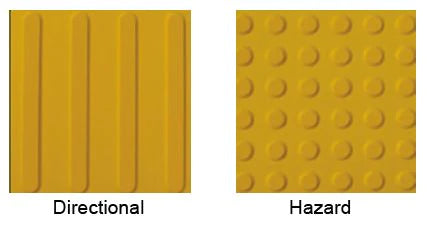
BTS Aust. Tactile Ground Surface Indicators (TGSI's)
TGSI's provide people who are Blind or have Low Vision with a uniform system of tactile cues which are identified by their feet or walking cane. The system has been developed to provide both ‘Directional’ and ‘Hazard’ warning cues.
Braille Tactile Signs Aust. is an established and experienced supplier of Tactile Ground Surface Indicator (TGSI) products including ceramic, polyurethane and stainless steel tiles, as well as individual metal and plastic flatback, and spigot and screw-in TGSI's in various colours. TGSI's are available in two forms, either in a ribbed format to provide “directional guidance” or in a studded format to provide “hazard warning”.
Why do we need to install TGSI's?
People with disabilities have the right to dignified, safe and independent access to buildings and other public facilities and services. As the population continues to age, it is estimated that the percentage of people with a degree of vision impairment will also grow significantly. The responsibility to cater for this segment of our population rests on those who design and build structures, in order to ensure a safe and easy access to public facilities.
TGSI Options & Information
- TGSI’s Polyurathane Tiles
- TGSI’s Ceramic Tiles
- TGSI’s Plastic
- TGSI’s Metal Individual
TGSI's - Polyurethane Tiles
SIZE: 300x300mm (Images are close up sections only)Tiles can adhere directly to surface.
COLOURS:
SAFETY YELLOW: Similar to PMS 1225c
BLACK: Similar to PMS Black 3c
See also our installation instructions.
Please contact our office for pricing and to discuss your specific TGSI requirements.TGSI's - Plastic Individual
SIZE: 35mm DiameterPattern on indicators are subject to changeInstallation templates are available for either option Plastic: Spigot only
COLOURS:
SILVER: Similar to PMS Cool Grey 9cC
GREY: Similar to PMS Cool Grey 7c
BLUE: Similar to PMS 2945c
RED: Similar to PMS 1807c
YELLOW: Similar to PMS 108c
Why are they available in different colours?
Up to 90% of people with vision impairment still retain some sight. For this reason, luminance contrast can play an important role. People with vision impairment use luminance contrast as well as tactile cues as a means of guidance.
 Site under construction
Site under construction






